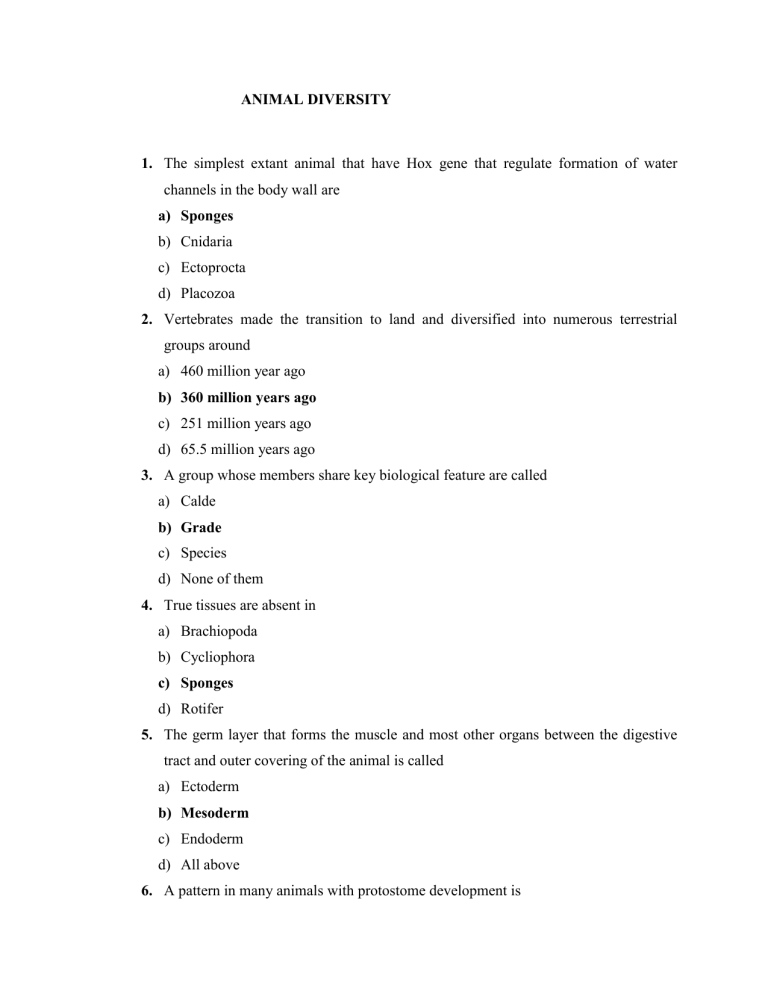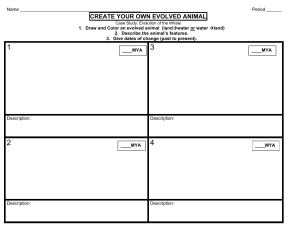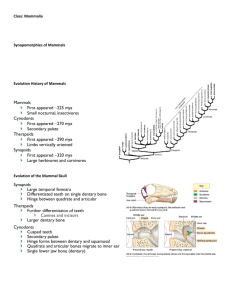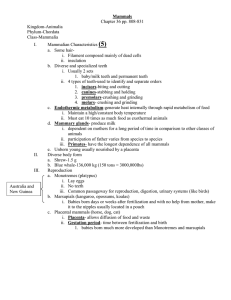
ANIMAL DIVERSITY 1. The simplest extant animal that have Hox gene that regulate formation of water channels in the body wall are a) Sponges b) Cnidaria c) Ectoprocta d) Placozoa 2. Vertebrates made the transition to land and diversified into numerous terrestrial groups around a) 460 million year ago b) 360 million years ago c) 251 million years ago d) 65.5 million years ago 3. A group whose members share key biological feature are called a) Calde b) Grade c) Species d) None of them 4. True tissues are absent in a) Brachiopoda b) Cycliophora c) Sponges d) Rotifer 5. The germ layer that forms the muscle and most other organs between the digestive tract and outer covering of the animal is called a) Ectoderm b) Mesoderm c) Endoderm d) All above 6. A pattern in many animals with protostome development is a) Spiral cleavage b) Determinate cleavage c) Radial cleavage d) Indeterminate cleavage 7. Example of deutrostome development is a) Annelids b) Mollusks c) Chordates d) Both a and b 8. A group that includes an ancestral species and all of its descendants are called a) Grade b) Clade c) Population d) Both a and b 9. Among the characteristics unique to animals is a) Gastrulation b) Flagellated sperm c) Multicellularity d) Heterotrophic nutrition 10. The distinction between sponges and other animal phyla is based mainly on the absence versus the presence of a) A body cavity b) True tissue c) A complete digestive tract d) Mesoderm 11. Acoelomates are characterized by a) The absence of brain b) A solid body without a cavity surrounding internal organ c) The absence of mesoderm d) Deutrostome development 12. Dinosaurs were the dominant land vertebrates during a) Neoproterozoic Era b) Paleoproterozoic Era c) Coenozoic Era d) Mesozoic Era 13. Brachiopods have a crown of ciliated tantacles that function in feeding called a) Ammonites b) Copepods c) Lophophore d) Padipalps 14. Which one is a clade of animals with true tissue a) Eumetazoa b) Ecdysozoa c) Lophotrochozoa d) Metazoan 15. The Cambrian explosion was followed by the a) Ordovician b) Silurian c) Devonian d) All above 16. Duration of Mesozoic Era is a) 1 Billion -542 MYa b) 542-521 MYA c) 251-65.5 MYA d) 65.5 MYA to present 17. All eukaryotes have genes that regulate the expression of other genes, and many of these regulatory genes contain common sets of DNA sequences called a) Homeoboxes b) Hox genes c) Genopore d) Ampulla 18. Extant species of animals that biologists have identified to date a) 1.2 million b) 1.3 million c) 1.4 million d) 1.5 million 19. Which one of the following play important roles in the development of animal embryo, controlling the expression of dozens or even hundreds of other genes that influence animal morphology a) Nervous system b) Cardiac system c) Homeobox d) Hox genes 20. The first generally accepted macroscopic fossils of animals range in age from a) 565-550 mya b) 565-542mya c) 575-550 mya d) 251-65.5 mya 21.How many species of living chondrichthyans? (a) 600 (b) 700 (c) 750 (d) 650 22.The dorsal fin of sharks act as…….. (a) Stabilizer (b) Byoyancer (c) Balancer (d) Detection 23.Sharks are………. (a) Bulk feeders (b) Suspension feeders (c) Fluid feeders (d) none of these 24.Large amount of oil in shark’s liver helps in……. (a) Buoyancy (b) Capturing prey exchange 25.Pectoral fins of rays act as…….. (c) Detoxification (d) gaseous Waterwings (b) venomous barb (c) claspers (d) whiplike 26. Mammals belong to the group of amniotes known as: a. Anapsids b. Synapsids c. None of these 27. A distinctive characteristic of synapsids is: a. Single temporal fenestra b. Double temporal fenestra c. Triple temporal fenestra 28. Hole behind the eye socket on each side of the skull is known as: a. Retina b. Optic nerve c. temporal fenestra 29. Synapsid evolved into large herbivores and carnivores during the period: a. Permian b. Triassic c. Jurassic 30. First true mammals arose in the period: a. Jurassic b. Triassic c. Cretaceous 31. Three major lineages of living mammals: monotremes, marsupials and eutherians emerged in: a. Early cretaceous period b. Permian c. Carboniferous period 32. Monotremes are found only in: a. Australia b. New Guinea c. Both a & b 33. Red kangaroo is about the size of: a. Horse b. Dog c. Honey bee 34. Marsupials existed worldwide during the era: a. Mesozoic b. Cenozoic c. Paleozoic 35. Today no. of marsupial families live outside the Australian region: a. Two b. Three c. Four 36. Eutherians are commonly called as: a. Placental mammals b. Egg laying mammals c. Marsupials 37. Eutherians have pregnancy longer than: a. Marsupials b Monotremes c.None 38. Humans are members of: a. Lemurs b. Monkeys c. Apes 39. Primates have: a. Large brain and short jaws b. Short brain and short jaws and large jaws 40. Monotremes diverged from other mammals: a. 150 MYA b. 180 MYA c. 120 MYA 41. Marsupials diverged from eutherians: a. 140 MYA b. 170 MYA c. 120 MYA 42. Elephants belong to order: a. Proboscidea b. Monotremata c. Xenarthras 43. Rabbits belong to order: a. Rodentia b. Lagomorpha c. Carnivora 44. Travelling by swinging from branch to branch in trees: a. Brachiating b.Crawling c.None 45. Lemurs, tarsiers, anthropoids belong to order: a. Primates b. Rodentia c. Carnivora 46. Tarsiers are more closely related to: a. Anthropoids b. Lemurs c. Birds c.Large brain 47. Apes diverged from: a. Old World monkeys b. New world monkeys c.Monotremes 48. Shy apes includes: a. Orangutans b. Gorillas c. Gibbons 49.Gorillas are: a. Largest apes b. smaller apes c.Shy apes 50. Homo sapiens are: a. 200,000 years old b. 30000 years old c. 17000 years old 51. Human genome resembles with apes: a.99% b. 97% c. 10% 52. Humans and chimpanzees differ in the expression of regulatory genes: a. 19 b. 27 c. 30 53. Study of human origin is known as: a. Paleoanthropology b. Paleontology c. Ethology 54. Hominins are more closely related to: a. Humans b. Chimpanzees c. Apes 55. Hominins brain have volume: a.400-450cm3 b. 300 cm3 56. Monotremes lack a. Nipples b. Hair c. Both 57.life has existed on Earth for at least a. 3.5 billion years ago b. 3.0 billion years ago c. 250-700cm3 c. 4.5 billion years ago d. 2.5 billion years ago 58.the genomes of humans and chimpanzees are same a. 99% b. 95% c. 90% d. 98% 59.humans and chimpanzees differ in the expression of ------regulatory genes. a. 19 b. 18 c. 17 d. 15 60.The study of -------- origins is known as paleoanthropology. a. Human b. Reptiles c. Fossils d. Arthropods 61. The hole at the base of the skull through which the spinal cord a. foramen magnum b. paramen magnum c. hind magnum d. thyroid magnum 62. The volume of human brain is a. 1300 cm³ b. 1000 cm³ c. 1500 cm³ d. 1200 cm³ 63. Hominin diversity increased dramatically between a. 4 and 2 million years ago. b. 5 and 6 million years ago. c. 3 and 4 million years ago. d. 2 and 3 million years ago. 64. Himalayanmountain range had formed, a. about 10 million years ago b. about 20 million years ago c. about 30 million years ago d. about 40 million years ago 65. As a chimpanzee walks, it uses the amount of energy used by a human. a. 2 times b. 3 times c. 4 times d. 6 times 66. Homo erectus originated in a. Africa b. America c. Europe d. Asia 67. human DNA show that Europeans and ------share a relatively recent common ancestor a. Asians b. Africans c. Australians d. Americans 68. miniature brains, a condition called microcephaly. a. microcephaly. b. Microrenology. c. microanthropology. d. Microcardiology. 69. Synapsids evolved into a large herbivores and carnivores during a. Permian period b. Cretaceous period c. Jurassic period d. periodTriassic 70. The ________ encloses a compartment of fluid that bath the embryo and act as shock absorber: a) Allantois b) Chorion c)Amnion 71.-------------- use their rib cages to ventilate their lungs: a) Anamniotes b)Amniotes c) both 72.The membrane of allantois functions with the -------------- as a respiratory organ: a) Amnion b) Chorion c) Yolk sac 73.The ---------- clade include the groups plesiosaurs and ichthyosaurs: a) Amphibians b) Reptiles c) birds 74.Snakes and Lizards are: a) Viviparous b) Oviparous c) Oviviviparous 75. The embryos of reptiles and mammals form ----------- extraembryonic membranes: a) Three b) four c) Two 76. Lizards and Snakes are ----------------: a)Warm blooded b) Endothermic c) Cold blooded 77. First major group of reptiles to emerg were: a)Parareptiles b) Diapsids c) Archosaurs 78. Ornithischians and Saurischiana are the lineages of ------------: a)Birds b) Reptiles c) Dinosaurs 79. The tuataras are about -------------cm long; a) 50 b) 40 c) 45 80. ------------ are the legless lepidosaurs: a) Lizards b) Tuataras c) Snakes 81. pleurodires and Cryptodires are the types of: a)Turtles b) Alligators c) crocodiles 82. Power for the flapping of the wings comes from the contraction of the large ------------muscles: a) Pectoral b) pelvic c) Both 83. Shaft and Barbules are the parts of bird’s: a) Neck b) Feather c) Mouth 84. ------------- are the amniotes that have hairs and produce milk: a) Reptiles b) Mammals c) Dipnoi 85. Mammals belong to the group of amniotes that called: a) Anapsids b) Synapsids c) Diapsids 86. Mammals have the _________ major lineages: a) Two b) Three c) Four b) Eutherians c) Marsupials 87. Egg laying mammals are: a) Monotremes




